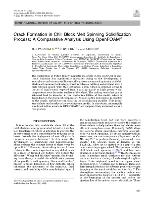Resumen
The application of FeSiB family magnetic materials in the electrical or electronic industry has significantly increased owing to the development of amorphous and nanocrystalline metallic glasses using melt spinning and chill block melt spinning technology, which involves a rotating metal wheel with a
high rotation speed. With this technique, a thin ribbon is obtained owing to the jet of liquid metal expelled from a casting nozzle at high pressure and temperature over the outer surface of the wheel. The cooling rates that can be achieved lead to disorder in the crystalline lattice of the metal, which is
dependent on the chemical composition. As soon as the material jet is expelled
by the nozzle, turbulence can occur in the solidification puddles. This generates defects and cracks in the solidification profile. In this study, numerically simulated ad hoc events in OPENFOAM are comparatively examined using a real process.














